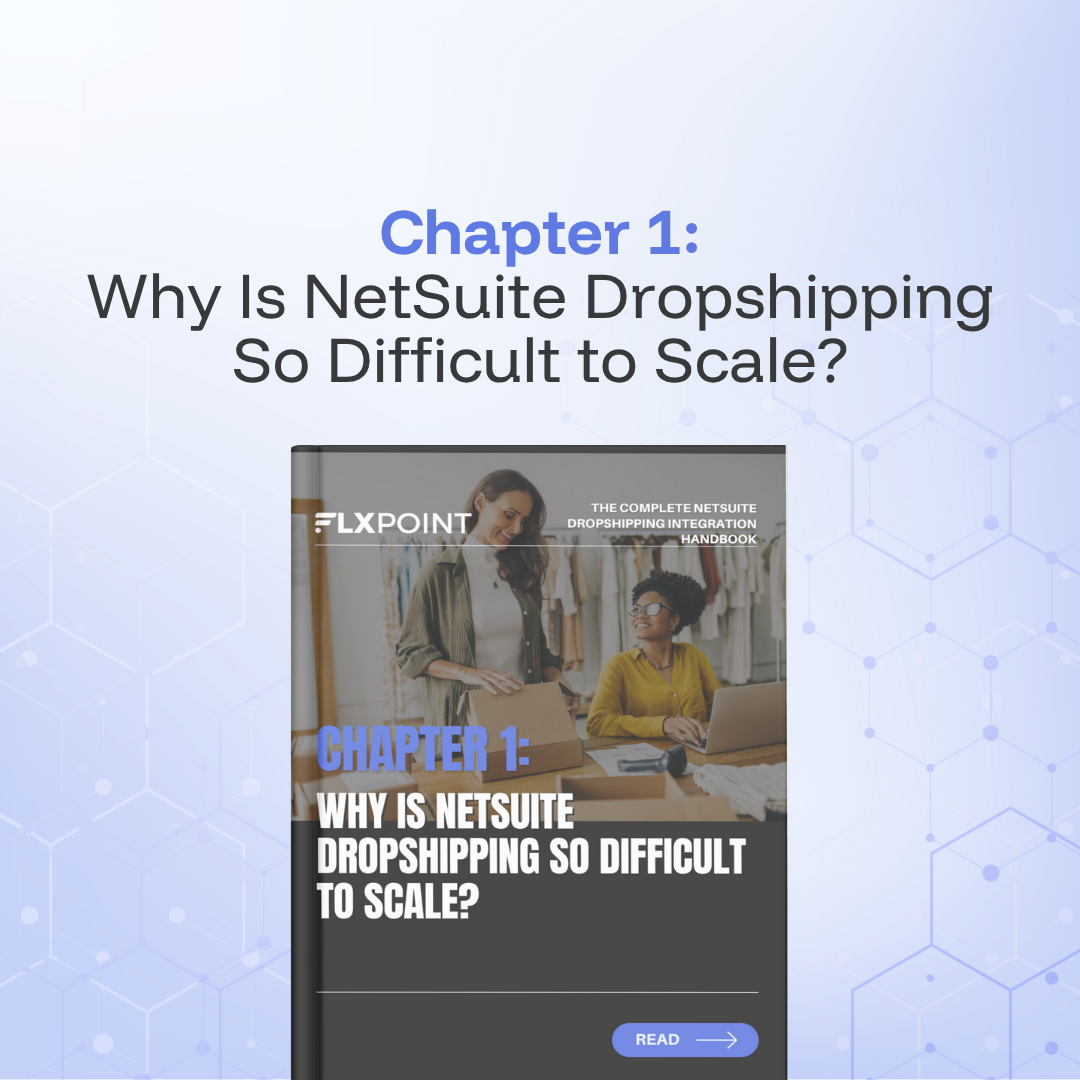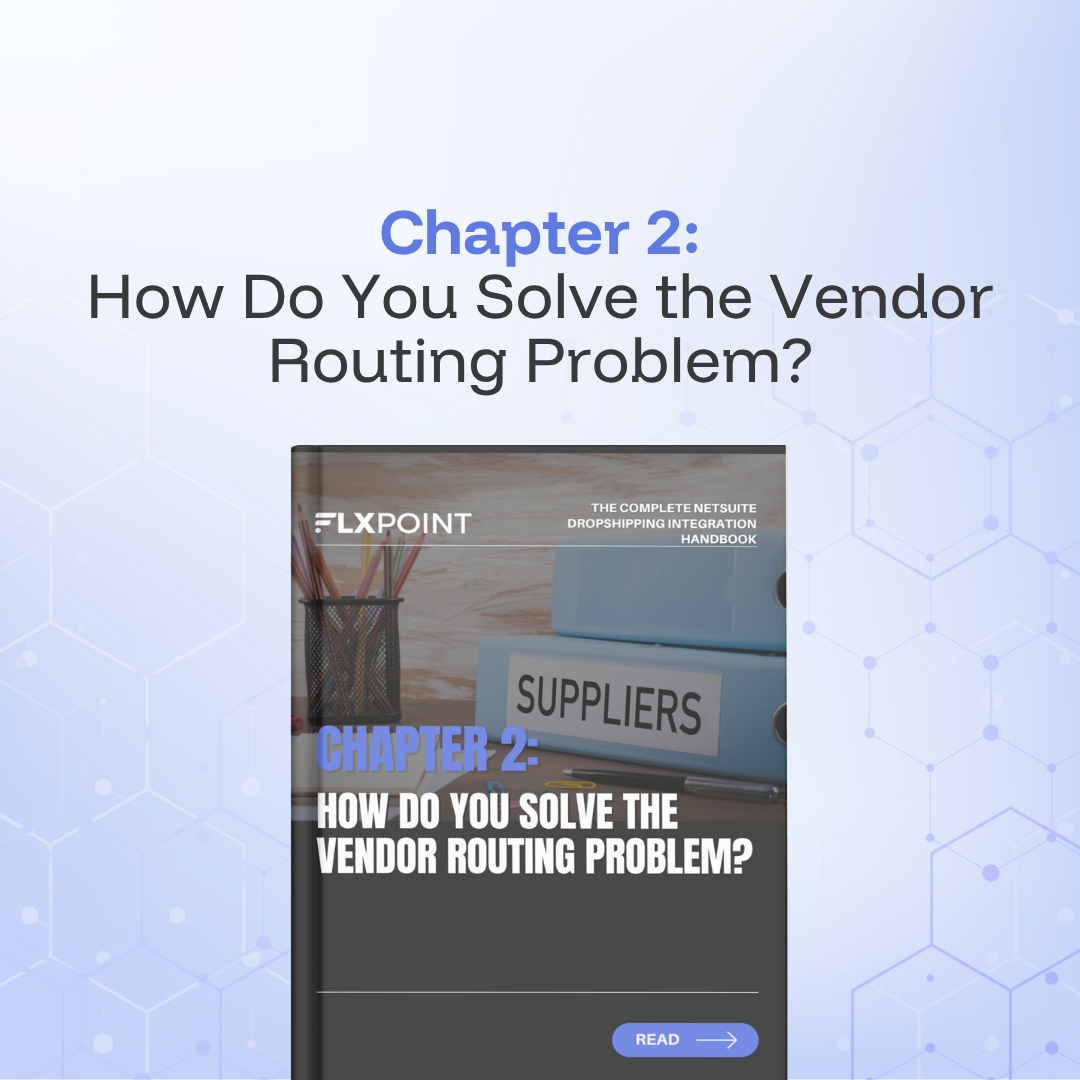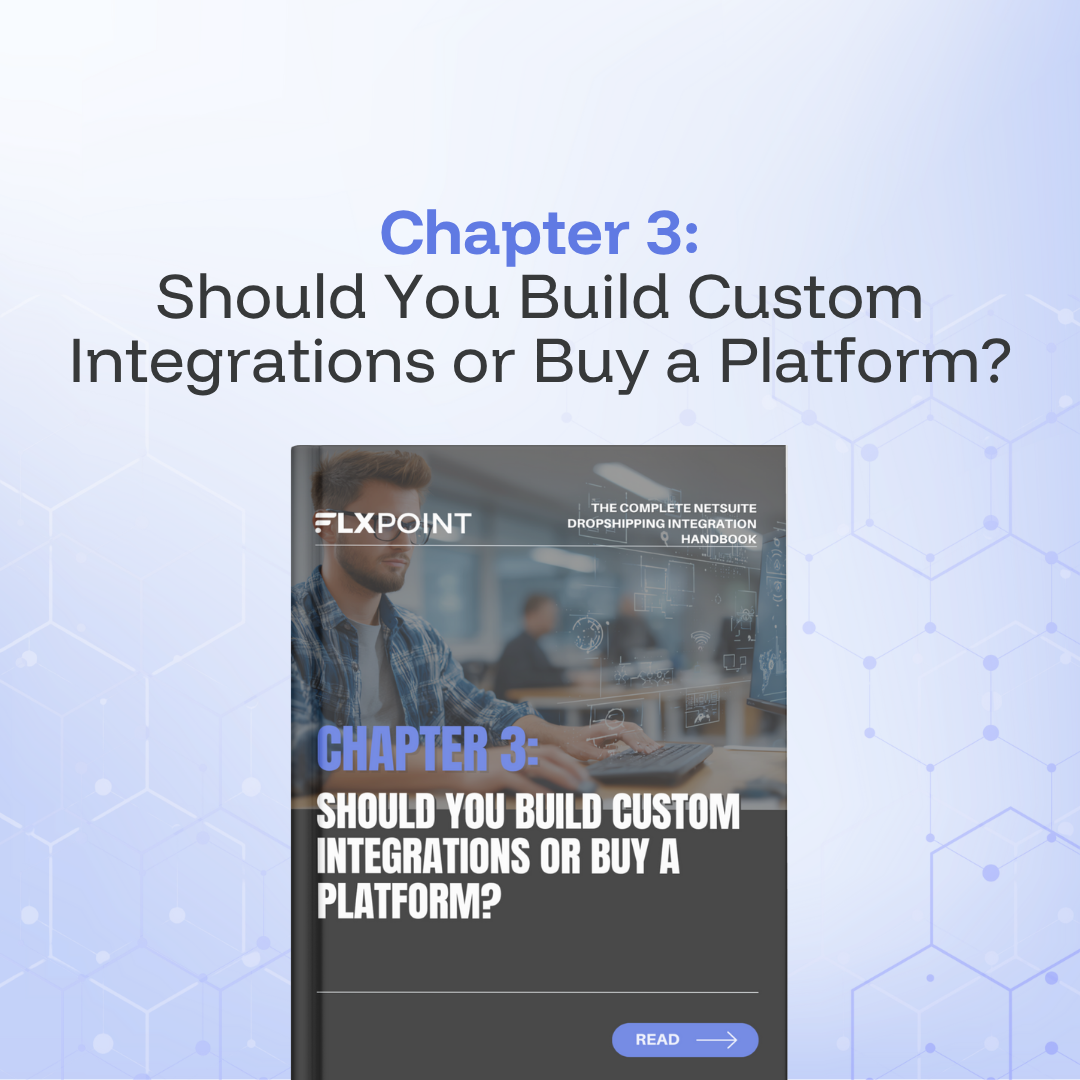Chapter 3 Should You Build Custom Integrations or Buy a Platform?

Building your own NetSuite integration sounds appealing; complete control, custom workflows, no recurring subscription costs. On paper, it seems like the smarter long-term investment. But as many merchants discover, the reality is far more complicated (and expensive) than it appears. The cost of building, maintaining, and scaling custom NetSuite integrations can quietly erode margins and stall growth before you even realize it.
In this chapter, we’ll explore the real economics of building versus buying, the hidden costs that are often ignored, and how pre-built platforms like Flxpoint deliver faster ROI while minimizing risk.
What Does Custom Development Really Cost?
The first thing most businesses notice about custom development is the price tag. Custom SuiteScript projects typically start in the tens of thousands; but the expense doesn’t stop there. Each change, update, or vendor integration adds new complexity and recurring costs.
The True Price of Control
Building a NetSuite integration from scratch means:
- Hiring (or contracting) NetSuite developers familiar with SuiteScript.
- Spending months designing, testing, and deploying integrations.
- Maintaining scripts as vendors or APIs evolve.
While custom work provides control, it also locks you into a cycle of dependency. You’re reliant on a developer or consulting team for every tweak; whether it’s adding a new supplier, updating a product feed, or fixing a routing rule.
If your internal developer leaves or your consulting partner shifts focus, knowledge transfer becomes a major issue. Every undocumented line of code becomes a future liability.
And since NetSuite scripts often run under governance limits, even seemingly small scripts can slow down or fail under large order volumes. This means ongoing maintenance just to keep things running smoothly.
Time-to-Value: The Silent Cost
Building an integration can take anywhere from six months to eighteen months to fully stabilize; depending on the number of vendors, fulfillment methods, and channels involved. During that time, your team is still manually managing orders, updating inventory, and approving purchase orders.
Every day spent in development is a day your competitors are automating and scaling faster.
In short, the custom route often looks like freedom; but it’s more like a full-time job you didn’t plan to hire for.
What Are the Hidden Costs Everyone Misses?
Even seasoned operations teams underestimate how complex ecommerce integrations can become once you move past one or two vendors.
Multi-Vendor Complexity
Integrating with multiple vendors; especially when they each use different file formats (EDI, API, FTP, or even emailed CSVs); isn’t just a one-time project. It’s an ongoing balancing act. Vendors change endpoints. File formats evolve. Error handling must be maintained. Each “simple” integration adds new failure points.
Then there’s the sales channel side. If you sell on Shopify, Amazon, Walmart, and your own site, each has unique data requirements, API limits, and order flow logic. Building connectors for these channels adds another layer of work; and risk.
Without self-service vendor tools, onboarding each vendor can take weeks. That means slower catalog expansion and missed revenue opportunities.
Downtime, Errors, and Technical Debt
Every script or custom connector introduces potential for downtime. One missed field, one API timeout, or one schema change can break your entire workflow. Your team ends up firefighting instead of scaling.
And because NetSuite doesn’t natively handle vendor automation or dynamic routing, each new requirement (like splitting an order across two vendors) means going back to the drawing board.
The more integrations you build, the more technical debt you accumulate. Over time, that slows innovation, increases maintenance costs, and limits your ability to pivot when the market changes.
The Unseen Cost of Opportunity
Manual vendor management, delayed orders, and error-prone scripts don’t just cost money; they cost momentum. Your operations team spends more time maintaining technology than improving strategy. That delay compounds over quarters, turning what once seemed like a cost-saving project into a bottleneck.
How Do Pre-Built Platforms Deliver Faster ROI?
For you as a customer, this means you immediately benefit from integrations other businesses have already paid to develop. That vendor you want to work with? There's a good chance the iPaaS like Flxpoint is already connected to them. Instead of spending $10,000 and three months building an integration, you enable it in an afternoon.
Flxpoint, for example, maintains:
- 20+ pre-built vendor system connectors for major distributors and 3PLs
- 200+ publicly integrated dropship suppliers across various industries
- 2,000+ privately integrated brands that customers have connected
- Standard integrations for popular ecommerce platforms (Shopify, BigCommerce, Amazon, Walmart, Magento, eBay)
This network effect accelerates your time to value exponentially. You can launch with multiple vendors in weeks instead of spending months integrating them one by one.
No-code configuration tools
Flxpoint understand that business users; not just developers; need to make adjustments. That's why they provide no-code or low-code configuration interfaces.
Instead of writing SuiteScript to map a vendor's CSV file to your NetSuite item records, you use a visual mapping tool:
- Upload a sample file from the vendor
- Drag and drop fields to match (Vendor Field: "prod_sku" → NetSuite Field: "Item ID")
- Set up transformations if needed (convert "Y/N" to true/false)
- Save the mapping template
- Schedule automatic imports
This approach means:
- Your operations team can handle routine changes without waiting for developers
- Onboarding new vendors happens in days, not months
- You can quickly adjust to vendor format changes without code deployments
- Business users have ownership over their processes
The same principle applies to order routing rules, product filtering, and workflow automation. Configure through interfaces instead of coding from scratch.
Continuous platform improvements
When you build custom, you own all future enhancements. Want to add a new feature? Pay for development. Need to adopt new NetSuite functionality? Pay for updates.
With a platform like Flxpoint, you benefit from continuous improvements the vendor makes:
- New vendor integrations added monthly
- Performance optimizations
- New features and capabilities
- Security updates and compliance requirements
- NetSuite API upgrades
These improvements happen automatically. You don't pay extra for them (beyond your subscription), and you don't need to manage their implementation.
Built-in vendor portal options
Not every vendor has sophisticated technology. Some dropship suppliers operate with basic systems or even manual processes. How do you integrate with them?
Flxpoint often provide self-service vendor portals where suppliers can:
- Upload product catalogs
- Acknowledge and manage orders
- Update tracking information
- Upload invoices for payment processing
- Print shipping labels and packing slips
This portal acts as a standardized interface that works for any vendor, regardless of their technical capabilities. It's far easier than building custom integrations for each low-tech vendor or, worse, handling them completely manually.
Professional implementation support
Pre-built integrated platforms come with expertise. The vendor has implemented their solution hundreds of times and knows:
- Common pitfalls to avoid
- Best practices for your industry
- Optimal configurations for different business models
- Troubleshooting techniques for issues
- Integration patterns that work well with NetSuite
During implementation, you're guided by professionals who've done this before. Compare this to figuring everything out yourself with custom development, where you're learning as you go and inevitably making costly mistakes.
Predictable costs
Custom development costs are notoriously difficult to estimate. Projects routinely run over budget and behind schedule. You might budget $75,000 and end up spending $120,000. You might plan for six months and take thirteen.
Platform pricing is transparent and predictable:
- Known monthly or annual subscription fees
- Clear implementation costs
- Defined timelines for go-live
You can accurately forecast costs and plan budgets accordingly. There are no surprise bills when integrations take longer than expected or when vendors change their systems.
The build vs. buy decision framework
Ask yourself these questions:
- How quickly do you need this operational? If the answer is "soon," platforms win.
- How many vendors do you plan to work with? More vendors favor platforms due to network effects.
- How often do vendors change their systems? Frequent changes make maintenance burden higher with custom code.
- What's your internal technical capacity? Limited IT resources favor platforms.
- How important is flexibility to experiment? If you need to iterate quickly, platforms provide more agility.
- What's your risk tolerance? Platforms reduce key person dependency and technical risks.
- Are integration and automation your core competency? If not, let specialists handle it.
For most NetSuite users tackling dropshipping automation, the answers to these questions point clearly toward buying a pre-built platform like Flxpoint rather than building custom solutions.
Stop spending months and tens of thousands of dollars building what already exists. Flxpoint's pre-built NetSuite integration includes vendor connectivity, dynamic routing, and item management; all ready to deploy in weeks. See how much faster (and cheaper) the platform approach can be and schedule a demo
Flxpoint – Powerful Dropship and Ecommerce Automation Platform
All Chapters in This Guide

When internal systems can't keep up with order volumes, manual item record creation becomes a bottleneck. Learn how high SKU counts and rigid preferred vendor logic limit your ability to scale dropshipping operations profitably.

Building upon proper vendor selection requires strategic order routing. The hidden costs of preferred vendor dependencies make scaling difficult. Dynamic multi-supplier routing unlocks margin protection while reducing split shipments. Discover how intelligent automation picks the best vendor for every order automatically.

Beyond obvious expenses like custom development costs, there are hidden expenses like ongoing maintenance and governance limits. SuiteScript customizations create technical debt while pre-built platforms offer faster time-to-value. Explore how enterprise platforms deliver ROI through vendor connectivity and reduced developer dependencies.

Flxpoint delivers extraordinary reliability, immediate integrations, intelligent support, and optimized real-time inventory management. Strategic platform adoption positions organizations for sustained growth with automated order fulfillment. See the complete workflow from order placement to customer delivery without manual intervention.
Kenneth Cole's Smart Savings With Shopify EDI Connections
"They had never used Flxpoint before. But working with [the Flxpoint] team, they learned it and we're about to onboard our newest footwear partner, and you know that's big business for us.”
Mitul PatelKenneth Cole


How Flxpoint Helped Rifle Supply Automate & Grow
“I went line by line… whatever the inventory number was and cost value was, I calculated it and was blown away by how much that was worth— $300 million worth of product that I added to our web store.”
Chris MekdaraRifle Supply


The Ecommerce Automation Behind Screen Skinz
"Automation is the key to maximizing your volume. [Flxpoint] comes right into our flow — everything's automated. We want it to be quick and efficient. So that's what we love about Flxpoint."
Shaun Brown & Clay CanningScreenSkinz


How Inhaven Transformed Vendor Management with Flxpoint
"We ended up switching to Flxpoint, and it has been a much smoother process. Where it took us six months to get onboarded with the other company, we were up and running in a week or two with Flxpoint."
Ashley ChingInhaven


How Black Patch Performance Scaled Smarter with Flxpoint
"The only way to actually scale was to go through Flxpoint… You can’t even come close to hiring someone to do what Flxpoint does for the price."
Jonathan WilliamsBlack Patch Performance


